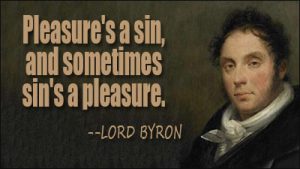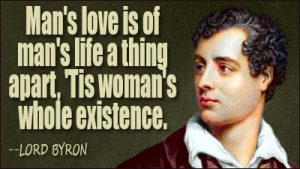When you think of the Romantic era you can probably imagine the time had it’s fair share of romance. Well one of the particularly famous (or perhaps infamous?) late romantics, Lord Byron, would certainly be no exception to this reputation. Yes indeed Mr. Byron, born George Gordon Byron, had a fun collection of sexual encounters to go with his emotionally-stirring literary works. It would be safe to assume he was a bit of a lady’s man, and perhaps a man’s man as well? That’s right, about a few years before good old Byron fell deeply in love with his distant cousin Mary Chaworth, he had his first few sexual encounters at age 12 with both boys and girls at his Howell School in London he attended. The late romantics did in fact share their predecessors of early Romanticism’s passion for liberty and self expression.
Now for those of you implicitly labeling this young child as a little on the wild and crazy side, you may be able to credit that behavior to his father who abandoned him or to his schizophrenic mother who abused him. Whichever it may have been, old Byron was certainly carrying around a medley of emotion with him that we can be somewhat thankful for as it set the stage for a riveting array of literary works, often involving a striking hero as a main character.
The trend of sexual escapades continued throughout his tenure at Trinity College from 1805 to 1808. To accompany these incidents he also managed to fall deep into debt and focus little on school while keeping busy with partying, gambling, boxing, and horse-riding. Amidst his busy schedule at Trinity, Byron was able to gain some traction in the literary field, gaining literary recognition from his satirical poem “English Bards and Scotch Reviewers,” which was his retaliation to harshly critical reviews of his first volume of poetry. However this lovely foundation he had set for himself did not keep him put in London; he decided to embark on a journey through the Mediterranean and Aegean Seas visiting several different countries. His experiences on this journey were reflected by the poem he wrote during it called “Child Harold’s Pilgrimage.” It was not until the death of his mother in July 1811 that Lord Byron returned to England, and her passing actually sent him into a deep depression despite her lack of a best mum award. But it wasn’t very long until our man of the hour got out of his slump and carried on a series of love affairs with several women, and later in the summer of 1813 found himself in a very intimate relationship with his half sister, Augusta, who was married at the time.
Possibly at an attempt to change his ways, Mr. Byron then tied the knot with the lovely and intellectual Annabella Milbanke and in December of 1815 they had a beautiful daughter together, whom of course Lord Byron chose to name Augusta. About a month later Annabella left Byron due to his increased drinking and debt along with all of the rumors of his relations with his half sister and his bisexuality. Understandably so, Byron then left England to never return and continued his treacherous journey elsewhere including Switzerland, Belgium and then Italy, where he went on to write his renowned masterpiece “Don Juan” and later in 1821 became an editor of “The Liberal,” a newspaper of a group of revolutionaries called The Carbonari Society. Finally in 1823, in a last heroic act Byron shows a noble side and accepts an invitation to aid in the Greek fight for independence from the Ottoman Empire, where he personally took command of a Greek unit of elite fighters. He then fell very ill the following year and sadly passed away on April 19, 1824 at the age of 36. He certainly left behind a legacy worth telling, of which the moral would probably be something along the lines of “be yourself.”
Resources:
http://www.biography.com/people/lord-byron-21124525#early-travel-and-writing
https://www.britannica.com/art/English-literature/The-later-Romantics-Shelley-Keats-and-Byron
https://www.poetryfoundation.org/poems-and-poets/poets/detail/lord-byron
Written by: Nicholas Desai



